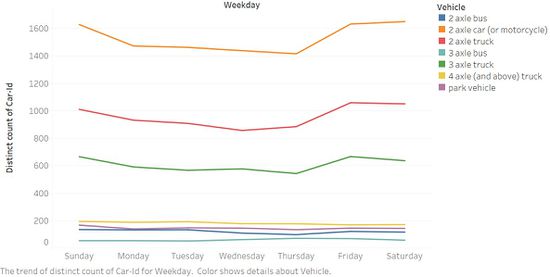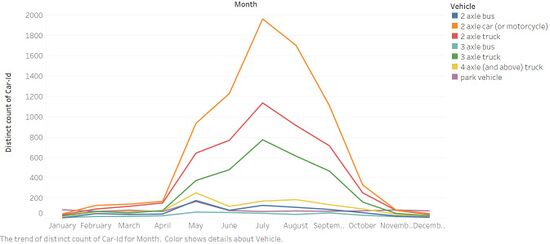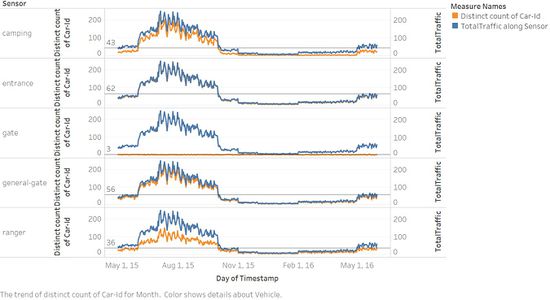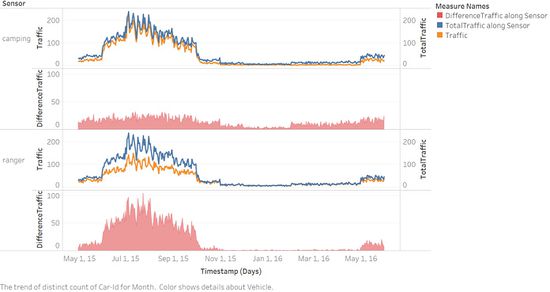Difference between revisions of "ISSS608 2016-17 T3 Assign MAO CHENXIN"
| Line 42: | Line 42: | ||
<br/> | <br/> | ||
From the weekday traffic: | From the weekday traffic: | ||
| − | * 2 axle car (or motorcycle), 2 axle truck and 3 axle truck were the most popular car types. For these 3 types of cars, most activities happened on weekends (from Friday to Sunday). | + | * 2 axle car (or motorcycle), 2 axle truck and 3 axle truck were the most popular car types used in the preserve. For these 3 types of cars, most activities happened on weekends (from Friday to Sunday). |
* No obvious changes of time for the other 4 types of cars - 2 axle bus, 3 axle bus, 4 axle (and above) truck and park vehicle ("2P"). | * No obvious changes of time for the other 4 types of cars - 2 axle bus, 3 axle bus, 4 axle (and above) truck and park vehicle ("2P"). | ||
| Line 48: | Line 48: | ||
[[File:Long2.jpg|550px]] | [[File:Long2.jpg|550px]] | ||
<br/> | <br/> | ||
| − | + | From the monthly traffic: | |
| + | * 2 axle car (or motorcycle), 2 axle truck and 3 axle truck were the most popular car types used in the preserve. | ||
| + | * Almost all the car types follow the seasonal popularity: summer (June - August) is the most popular season, followed by autumn (September and October) and spring (April and May), except 3 axle bus. | ||
<br/><br/> | <br/><br/> | ||
Revision as of 00:05, 8 July 2017
Contents
Problem and Motivation
Mistford is a mid-size city is located to the southwest of a large nature preserve. The city has a small industrial area with four light-manufacturing endeavors. Mitch Vogel is a post-doc student studying ornithology at Mistford College and has been discovering signs that the number of nesting pairs of the Rose-Crested Blue Pipit, a popular local bird due to its attractive plumage and pleasant songs, is decreasing! The decrease is sufficiently significant that the Pangera Ornithology Conservation Society is sponsoring Mitch to undertake additional studies to identify the possible reasons. Mitch is gaining access to several datasets that may help him in his work, and he has asked you (and your colleagues) as experts in visual analytics to help him analyze these datasets.
The dataset is taken from Visual Analytics Community: VAST Challenge 2017- Mini Challenge 1
Mini Challenge 1
The Boonsong Lekagul Nature Preserve is used by local residents and tourists for day-trips, overnight camping or sometimes just passing through to access main thoroughfares on the opposite sides of the preserve. The entrance booths of the preserve are monitored in order to generate revenue as well as monitor usage. Vehicles entering and exiting the preserve must pay a fee based on their number of axles (personal auto, recreational trailer, semi-trailer, etc.). This generates a data stream with entry/exit timestamps and vehicle type. There are also other locations in the part that register traffic passing through. While hiking through the various parts of the preserve, Mitch has noticed some odd behaviors of vehicles that he doesn’t think are consistent with the kinds of park visitors he would expect. If there were some way that Mitch could analyze the behaviors of vehicles through the park over time, this may assist him in his investigations.
Questions
- “Patterns of Life” analyses depend on recognizing repeating patterns of activities by individuals or groups. Describe up to six daily patterns of life by vehicles traveling through and within the park. Characterize the patterns by describing the kinds of vehicles participating, their spatial activities (where do they go?), their temporal activities (when does the pattern happen?), and provide a hypothesis of what the pattern represents (for example, if I drove to a coffee house every morning, but did not stay for long, you might hypothesize I’m getting coffee “to-go”). Please limit your answer to six images and 500 words.
- Patterns of Life analyses may also depend on understanding what patterns appear over longer periods of time (in this case, over multiple days). Describe up to six patterns of life that occur over multiple days (including across the entire data set) by vehicles traveling through and within the park. Characterize the patterns by describing the kinds of vehicles participating, their spatial activities (where do they go?), their temporal activities (when does the pattern happen?), and provide a hypothesis of what the pattern represents (for example, many vehicles showing up at the same location each Saturday at the same time may suggest some activity occurring there each Saturday). Please limit your answer to six images and 500 words.
- Unusual patterns may be patterns of activity that changes from an established pattern, or are just difficult to explain from what you know of a situation. Describe up to six unusual patterns (either single day or multiple days) and highlight why you find them unusual. Please limit your answer to six images and 500 words.
- What are the top 3 patterns you discovered that you suspect could be most impactful to bird life in the nature preserve? (Provide a short text answer.)
Tools Utilized
- Tableau 10.2
- JMP Pro 13
Results
Question 1: Daily patterns of life by vehicles
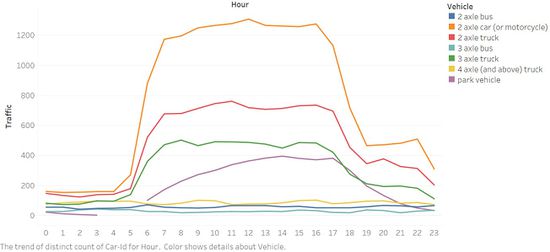
From the daily traffic in 24 hours:
- 2 axle car (or motorcycle), 2 axle truck and 3 axle truck were the most popular car types. For these 3 types of cars, most activities happened from 5am to 22pm. 7am to 4pm was the peak time.
- For park vehicle (with the type "2P" in the dataset), the working hours is from 6am to 3am (next day). At 17pm, the number of rangers' cars decreased significantly, when the numbers of 2 axle car (or mobile), 2 axle truck and 3 axle truck decreased as well.
- No obvious changes of time for the other 3 types of cars - 2 axle bus, 3 axle bus and 4 axle (and above) truck. Besides, these 3 types of cars account for the least traffic in the preserve from May 2015 to May 2016.
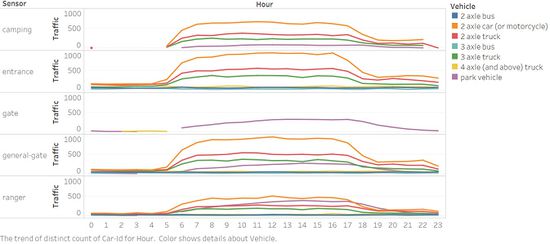
From the daily traffic by sensors:
- For camping, there are only three types of cars - 2 axle car (or motorcycle), 2 axle truck and 3 axle truck. Almost all of these cars traveled in and out the camping site from 5am to 22pm.
- Only Park Vehicle and 4 axle (and above) truck accessed gate, from 6am to 2am and from 2am to 5am respectively.
Question 2: Long-term patterns
- 2 axle car (or motorcycle), 2 axle truck and 3 axle truck were the most popular car types used in the preserve. For these 3 types of cars, most activities happened on weekends (from Friday to Sunday).
- No obvious changes of time for the other 4 types of cars - 2 axle bus, 3 axle bus, 4 axle (and above) truck and park vehicle ("2P").
- 2 axle car (or motorcycle), 2 axle truck and 3 axle truck were the most popular car types used in the preserve.
- Almost all the car types follow the seasonal popularity: summer (June - August) is the most popular season, followed by autumn (September and October) and spring (April and May), except 3 axle bus.
Question 3: Unusual patterns
Question 4: Top3 impactful to birds
